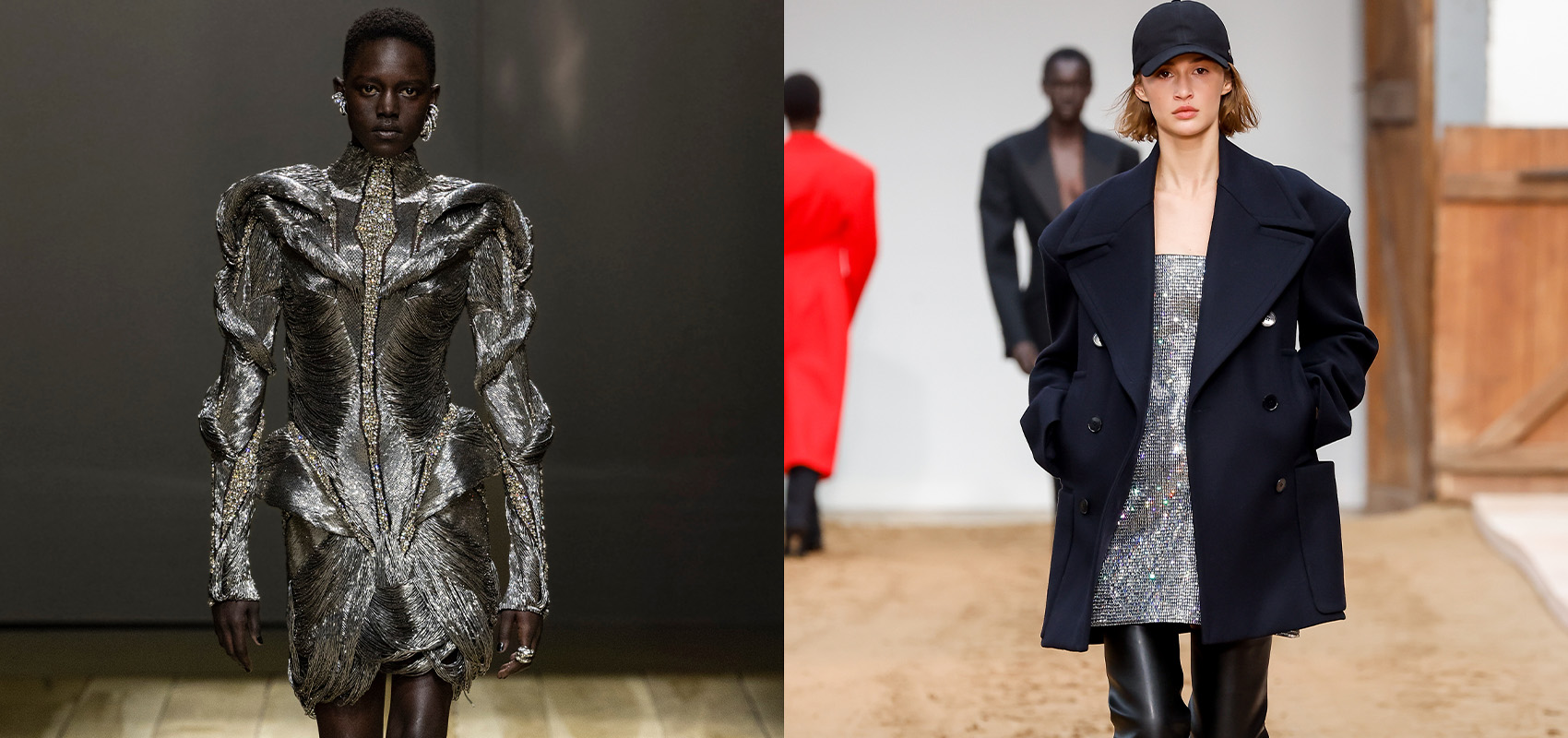Robot dogs and Uncle Fester shoulders: a Paris Fashion Week recap.
Nine days, 66 runway shows, and 41 presentations. The dust has settled on Paris Fashion Week: UberEats deliveries have been ordered, and heels kicked off as the fashion community nurses their social batteries (and possibly hangovers.)
There were a few firsts this season. The first Nina Ricci show with Central Saint Martins graduate Harris Reed at the helm. Reed’s own brand is known for gender fluidity and dramatic headwear, the latter of which certainly translated to their first Nina Ricci endeavor. The first Ann Demeulemeester show under Ludovic de Saint Sernin, for which the designer brought his signature sex appeal with opening and closing looks where model’s chests were obscured by a single, horizontal feather. (Euphoria’s Hunter Schafer wore one to the Vanity Fair Oscars party just days after it showed.)
The first Vivienne Westwood show since her death was closed out by her granddaughter, Cora Corré, wearing Westwood’s signature horns and a white lace bodice that looked like it could have been stolen from a wedding dress. It was also the first show since Paco Rabanne’s death, another late fashion legend. In a tribute, the finale featured Rabanne’s famous chainmail dresses from the house archive.
It was also the first Balenciaga show post-controversy and the first under Demna Gvasalia that aimed to focus on the clothes more than the hype and spectacle surrounding them after years as fashion’s hype-merchant. The brand’s show notes read, “…fashion to me can no longer be seen as an entertainment, but rather as the art of making clothes.”
Elsewhere, not everyone agreed with Gvasalia. A popular word online in recent seasons has been “gimmick,” used to describe collections that aim to make a social media splash with runway theatrics rather than letting clothes speak for themselves. Last season, Coperni’s spray-on dress on Bella Hadid was arguably the most memorable show of the month. This time, the brand turned to technology again, with robot dogs carefully ripping clothes off the models. At Heliot Emil, a model/stuntman walked down the runway in flames.
Even the FROW was focused on hype. Estonian rapper Tommy Cash came to the Y/Project show draped in a duvet with a pillow attached to his head, and bed hair splayed out, a move inspired by the Viktor & Rolf fall 2005 show. Cash is known for his fashion week antics: last year alone, he knitted on the front row at Loewe, dressed as a baby in a stroller for Marine Serre, pumped iron at Amiri, and carried a woman strapped to his back like a back-pack for Rick Owens.
Courrèges’ runway had something to say about how fashion shows are consumed—not just on the front row, but online. Nicolas Di Felice’s Courrèges show opened with a model staring down at her phone, face illuminated, screen providing the only light source. At Loewe, white satin shift dresses were blurrily printed with other garments, exploring the way we see clothes in a snapshot online versus in real life. From the front (the way most garments are seen online), a black strapless dress with a pointed bust looked unassuming, but from the side, it’s stiff and sculptural, coming off the body.
Another word that comes to mind this season is “disheveled,” a trend continued from last year. Miu Miu channeled librarian chic with knitwear and kitten heels, but the edginess came from messy hair sported by the models and tights pulled up too high, covering cardigans. (The peeking-out of undergarments has been trending for some time, with Miu Miu models at previous shows proudly sporting briefs that rose above the waistline.) Acne Studios continued its grunge undertones with fabrics that were treated to appear faded, wrinkled, or distressed. Yohji Yamamoto was a vision of frayed edges and deconstructed silhouettes (an unsurprising move for one of the major players of ’90s anti-fashion.)
The opposite of grungy messiness, some brands went for old-school glamor. True to its founder, the couturier Pierre Balmain, the brand showed silhouettes reminiscent of mid-century couture, exaggerated with embellishments, enlarged bows, and PVC. Schiaparelli’s first ready-to-wear show presented elegant silhouettes and referenced house codes via details like keyholes. Saint Laurent served up ’80s power suits with strong shoulders and oversized, draped shawls. Strong shoulders are another ongoing trend, whether too-wide at Courréges to seem like a kid parading in their dad’s clothes, or enlarged with pads like at Balenciaga to create a whacky, permanent-shrug silhouette (not unlike Uncle Fester’s.)
Sparkles continue to illuminate many a runway in the form of glitter, sequins, or crystals: McQueen, Celine, Chanel, Dior, Louis Vuitton, Stella McCartney, and Valentino all took part. Even Rick Owens, known for his stylish severity and “prince of darkness” reputation, featured a host of metallic sequined looks, though they were less New Year’s Eve sparkly and more the colors you might see in an oil puddle: pink, purple, green, and silver.
It was a season of opposites. Some designers strove to go viral with gimmicks and theatrics, while others made a point of focusing on the clothes. (Is announcing that you’re focusing on the clothes a gimmick in itself when you’re so renowned for your theatrics?) Grunge and sleaze came through via messy styling and distressed clothing, and old school glamor took us back to couture’s heyday. Like present culture, fashion seems polarized.
Images courtesy of Miu Miu, Stella McCartney, and Alexander McQueen.





